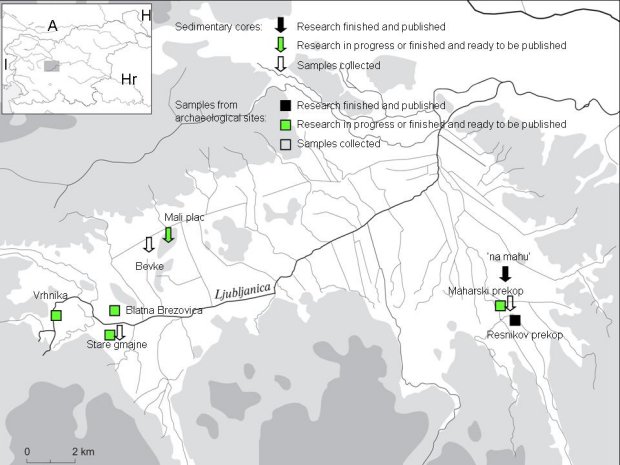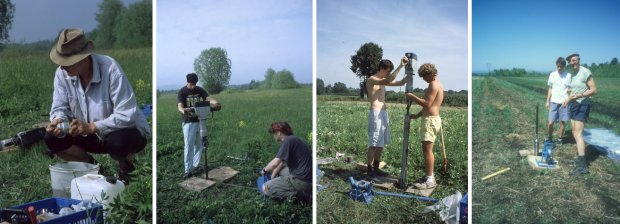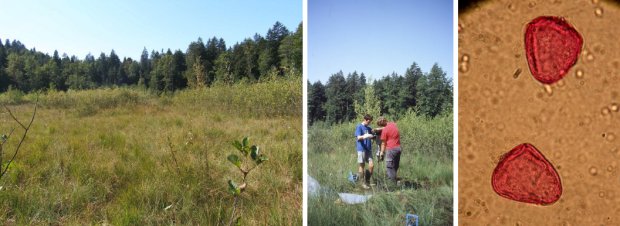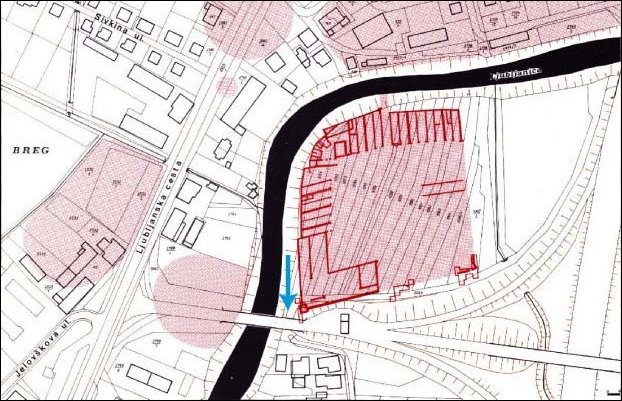Current research: Ljubljansko barje
Palynology: Research equipment | Reference collections | Links | Long-term environmental changes
Current research: Ljubljansko barje
Ljubljansko barje is -palaeoecologically and archaeologically- most investigated region of Slovenia. Pollen in cultural layers of many archaeological sites is well preserved due to high groundwater level, and pollen preservation in underlying carbonate sediment is excellent. Palynological research of sedimentary cores and samples from archaeological sites is being carried out in the region.
- Palynological research of pile-dwelling settlements
- Pollen analysis of sedimentary cores
- Vrhnika (Dolge njive)

Palynological research at pile-dwelling settlements
Pollen grains, which deposited in cultural layers of pile-dwelling settlements at Ljubljansko barje, were coming from vegetation that was growing around archaeological sites. Oak (which was used for building material), beech, fir, hornbeam and spruce were most common trees in the region. Alder was growing on wet ground, whereas high percentage of hazel pollen suggests that the landscape was rather open due to human impact on the environment. Pollen of plants that were cultivated on fields (e. g. cereals, flax and weeds, such as goosefoot and mugwort) was brought to the settlement together with crops. Pollen of ribwort plantain, which is grazing indicator, was also discovered. By analysing pollen from archaeological sites, palynologists can, in cooperation with archaeologists, archaeobotanists and archaeozoologists, contribute to reconstruction of past environment and help to understand the way of life of past inhabitants of Ljubljansko barje

The results of palynological research at archaeological sites Stare gmajne, Blatna Brezovica and Maharski prekop will be published in a book (serial publication Opera Instituti Archaeologici Sloveniae, planned for 2013).
Literature
Andrič, M., J. Turk in A. Velušček. 2005. Palynological and sedimentological research on Ljubljansko barje (Slovenia). Resnikov prekop site – preliminary results. Strani 219-220 v P. Della Casa in M. Trachsel (ur.). WES '04. Wetland Economies and Societies. Proceedings of the international conference Zurich, 10-13 March 2004, Collectio archaeologica 3, Zürich: Schweizerisches Landesmuseum Zürich Bundesamt für Kultur, Chronos Verlag.
Andrič, M. 2006. Ali lahko analiza pelodnega zapisa v kulturni plasti arheološkega najdišča pove, kakšna vegetacija je rasla v okolici? Primer: Resnikov prekop. Does pollen record in archaeological ‘cultural layer’ tell us what vegetation was growing around the settlement? Case study: ‘Resnikov prekop’. Strani 103-113 v A. Velušček (ur). Resnikov prekop, najstarejša koliščarska naselbina na Ljubljanskem barju, Resnikov prekop, the oldest Pile-Dwelling Settlement in the Ljubljansko barje. Opera Instituti Archaeologici Sloveniae 10.
Rezultati palinoloških raziskav na arheoloških najdiščih Stare gmajne, Blatna Brezovica in Maharski prekop bodo objavljeni v znanstveni monografiji (izid predviden leta 2013).
Pollen analysis of sedimentary cores
Pollen, which is preserved in lake and marsh sediments of Ljubljansko barje reveals vegetation history and helps us to better understand long-term environmental processes. Towards the end of the last Ice Age, ca. 15000-11500 years ago, open woodland comprised predominantly of pine and birch was growing in the area, together with individual broadleaved trees. At the Lateglacial-Holocene transition, when the climate became warmer and wetter, broadleaved tree taxa (oak, elm, lime, ash and hazel) increased, but very soon beech forests started to dominate. Fir began to increase ca. 9000 years before present.
Next major change of vegetation at Ljubljansko barje happened between ca. 6750 and 6000 years before present, when beech and fir declined, together with an increase of oak, alder and hazel. The reasons for this decline of beech-fir forests are not clear: we suggest that changes of forest composition can be associated with climatic fluctuations and/or hydrological changes in the basin (drier climate and lower water levels), although the impact of Neolithic inhabitants of Ljubljansko barje on the vegetation cannot be completely ruled out. 6000 years ago beech and fir increased again and the impact of pile-dwelling farmers on the landscape was significant. The vegetation development in the last 4500 years is poorly investigated because younger palaeoecological record was destroyed by peat cutting and burning in the 18th and 19th century. (Andrič et al. 2008).

Interdisciplinary cooperation with partner institutions is very important part of palaeoecological research at Ljubljansko barje. Microfossils, for example diatoms, can be preserved in lake sediments, which together with the geochemical composition of the sediment can help us to reconstruct past hydrological conditions in the basin. Interdisciplinary research of ‘na mahu’ sedimentary core (Andrič et al. 2008), for example, revealed that in the Lateglacial Ljubljansko barje was probably covered by a deep, oligotrophic lake, with a significant terrestrial input due to soil erosion, (presumably triggered by cold climate and open vegetation). At the beginning of the Holocene the amount of nutrients in the basin increased and the lake became shallower. The landscape stabilised due to vegetation re-growth (beech-fir forests). Between 6750 and 6000 years before present, when beech-fir forests were retreating, oligotrophic conditions returned, terrestrial input increased, there are indicators of running water, which might be a consequence of lower water level due to drier climate. About 6000 years ago wetter, eutrophic conditions returned and about 5200 years before present peat started to grow at ‘na mahu’ site.

Mali plac is one of very few sites at Ljubljansko barje, where peat was not cut and burnt and pollen record for the last 4500 years is still preserved.
Literature
Andrič, M. 2007. Why were the Neolithic landscapes of Bela krajina and Ljubljana Marshes regions of Slovenia so dissimilar? Documenta Praehistorica 34: 177-189.
Andrič, M., B. Kroflič, M. J. Toman, N. Ogrinc, T. Dolenec, M. Dobnikar, B. Čermelj, 2008. Late Quaternary vegetation and hydrological change at Ljubljansko barje (Slovenia), Palaeogeography, Palaeoclimatology, Palaeoecology 270, 150-165.
Andrič, M. 2009. Klimatske spremembe in barjansko rastlinstvo koncem pleistocena in v holocenu, Strani 20-23 v: P. Turk, J. Istenič, T. Knific and T. Nabergoj (ur.), Ljubljanica – kulturna dediščina reke, Ljubljana, Narodni muzej Slovenije.
Andrič, M. 2009. Holocenske paleoekološke in paleohidrološke razmere na Ljubljanskem barju – prispevek k diskusiji. The Holocene palaeoecological and palaeohydrological conditions at Ljubljansko barje – a contribution to discussion. Arheološki vestnik 60: 317-331.
Vrhnika (Dolge njive)
Roman settlement Dolge njive was established at about 50-20 cal. BC, on the right bank of the Ljubljanica river. Pollen in alluvial sediment, which lies directly below archaeological cultural layers, was analysed.

Literature
The results of pollen analysis at Vrhnika are planned to be published in Arheološki vestnik 64 (2013).
Bela krajina | Archaeological sites in Ljubljana | Julian Alps | Solčavsko | Dinarids | Čičarija and Čepićko polje (Croatia) | Tatarli Höyük (Turkey)